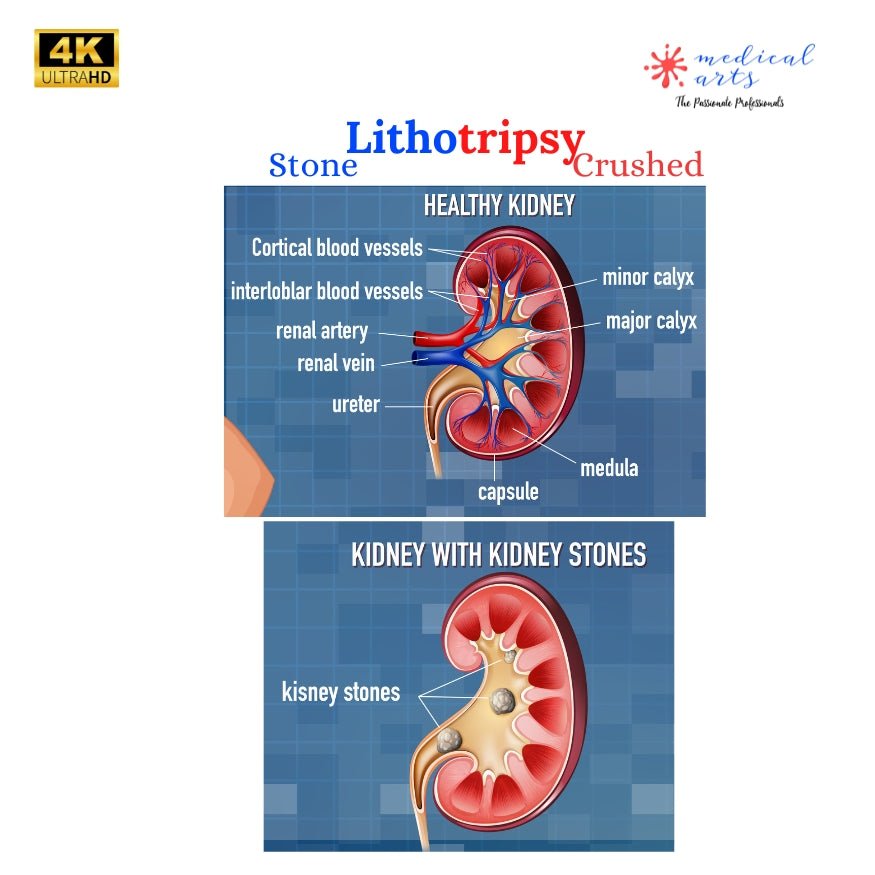Understanding Lithotripsy: The Kidney Stone Removal Procedure
Kidney stones are a common urological condition affecting millions worldwide. When faced with the severe discomfort caused by these stones, many patients seek effective, less invasive treatment options.
Lithotripsy, a medical procedure designed to break kidney stones into smaller pieces that can be passed naturally, is one such solution. This article will delve into the details of lithotripsy, including its types, effectiveness, procedure, and statistics.
What is Lithotripsy?
Lithotripsy is a medical procedure that uses shock waves or laser energy to break kidney stones into small fragments. These fragments can then pass through the urinary tract more easily. Lithotripsy is highly valued for its non-invasive nature, significantly reducing recovery times and potential complications compared to traditional surgical methods.
Types of Lithotripsy
There are two main types of lithotripsy:
-
Extracorporeal Shock Wave Lithotripsy (ESWL):
- This is the most common form of lithotripsy. It involves using shock waves generated outside the body to target and break up kidney stones.
- The procedure is usually performed under sedation or light anesthesia, ensuring the patient remains comfortable.
-
Laser Lithotripsy: (seen in the video above)
- This method involves inserting a thin, flexible ureteroscope into the urinary tract to visualize and break the stones using laser energy.
- Laser lithotripsy is often used for stones in the lower urinary tract or when ESWL is ineffective.
How Does Lithotripsy Work?
The process of lithotripsy involves several key steps:
-
Preparation:
- Before the procedure, your doctor will conduct a thorough examination, including imaging tests like X-rays or ultrasounds, to determine the kidney stones' size, location, and composition.
-
During the Procedure:
- For ESWL, you'll lie on a unique table or in a water bath. The shock wave generator is positioned to focus on the kidney stone. Shock waves are emitted, passing through your body and breaking the stone into smaller pieces.
- For laser lithotripsy, a ureteroscope is inserted through the urethra and bladder into the ureter. The laser fibre is then used to fragment the stone.
-
Post-Procedure:
- After the procedure, you'll be monitored briefly before being allowed to go home. Pain medication and instructions on how to manage any discomfort will be provided.
- Drinking plenty of water is essential to help flush out the stone fragments through your urine.
Benefits of Lithotripsy
- Non-Invasive: ESWL doesn't require incisions, making it less invasive than traditional surgery.
- Quick Recovery: Most patients can resume normal activities within a few days.
- Effective: Lithotripsy has a high success rate for breaking up small to medium-sized stones.
Potential Risks and Complications
While lithotripsy is generally safe, it's essential to be aware of potential risks and complications, including:
- Discomfort and Pain: Some discomfort during and after the procedure is common but manageable with medication.
- Bleeding and Bruising: Minor bleeding or bruising can occur in the treated area.
- Stone Fragments: Not all fragments may pass immediately, sometimes requiring additional procedures.
How Effective is Lithotripsy?
Lithotripsy has proven to be a highly effective treatment for kidney stones. According to the American Urological Association, ESWL successfully treats about 70% to 90% of patients with kidney stones less than 20 mm in diameter. Laser lithotripsy boasts a similar success rate, especially for stones located in the lower urinary tract.
1. Preparation:
- Before the procedure, a thorough examination, including imaging tests such as X-rays or ultrasounds, is conducted to determine the kidney stones' size, location, and composition.
2. During the Procedure:
- ESWL: The patient lies on a special table or in a water bath. Shock waves are generated and focused on the kidney stones. These waves travel through the body, breaking the stones into smaller pieces.
- Laser Lithotripsy: The ureteroscope is inserted through the urethra and bladder to reach the stone. A laser fibre is then used to break the stone into fragments.
3. Post-Procedure:
- After lithotripsy, patients are monitored for a short period before being discharged. Pain management and post-procedure care instructions are provided.
- Drinking plenty of water is crucial to help flush out the stone fragments through the urine.
- In the United States, over 1 million cases of kidney stones are diagnosed annually, with many treated via lithotripsy.
- ESWL is used in approximately 70% of all lithotripsy procedures, with a success rate ranging from 70% to 90%.
- The success rate of laser lithotripsy is comparable, particularly effective for stones in the lower urinary tract.
- A study published in the Journal of Endourology reported a 95% stone-free rate for patients undergoing laser lithotripsy for ureteral stones.
Conclusion
Lithotripsy offers a compelling solution for kidney stone removal, combining effectiveness with minimal invasiveness. If you're struggling with kidney stones, discuss with your healthcare provider whether lithotripsy is the right option for you. You can confidently approach your treatment by understanding the procedure and what to expect.

